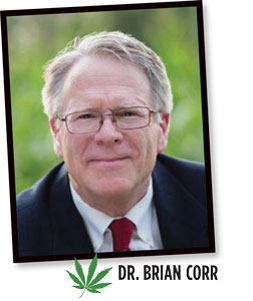9/1/2020
Bitter With the Better
Dr. Brian Corr

When I was first asked to consult in the cannabis industry, I initially said I wasn’t interested because of my preconceived notions about cannabis and cannabis users. But I did my homework and learned there was more to cannabis than I initially thought. Use of cannabis has health benefits documented by numerous studies.
The National Academies of Sciences, Engineering, and Medicine published a 487-page report regarding the health effects of cannabis. This report summarized research that showed cannabis could provide pain relief, reduce muscle spasms in patients with multiple sclerosis, and prevent or minimize nausea and vomiting caused by chemotherapy.
It was reports like this, and stories told to me by patients who benefited from the use of cannabis, that made me an advocate for sensible use of cannabis. I’ve told some of those stories in these columns.
However, every yin has a yang. Or as my grandmother would say, sometimes there is bitter with the better. With over 200 million users worldwide, and cannabis legalization spreading in U.S. states, evidence is emerging of some unpleasant consequences.
Early studies showed no change in traffic fatalities in the U.S. states of Colorado or Washington after those states legalized cannabis for general adult use. That seemed too good to be true, since research had shown cannabis use could inhibit the ability of drivers to maintain their car within a lane. Researchers have demonstrated 9-tetrahydrocannabinol (THC—the compound in cannabis responsible for the “high”) increases the time needed to react and interferes with attention, decision making, impulse control and memory, all of which are necessary for safe driving.
In June of 2020, two studies were published in the Journal of the American Medical Association contradicting the earlier studies regarding traffic fatalities. One looked at changes in traffic fatality rates in Colorado, Washington, Oregon and Alaska for two years after cannabis became available for general adult use. Even after correcting for changes in unemployment rate, speed limits and primary seatbelt laws, the study found an increase of 2.1 traffic fatalities per billion vehicle miles traveled.
While these studies on traffic fatalities are recent, there have been multiple studies for years showing there are other undesirable consequences of cannabis use.
A well-known study was published in 1987 investigating the relationship between cannabis use and schizophrenia. In this study, 45,570 Swedish military conscripts were studied over 15 years. Those conscripts, who were considered to be heavy users of cannabis, had a significantly higher risk for schizophrenia over the duration of the study. Does this mean people with a greater risk for schizophrenia are more likely to use cannabis? Or does it mean cannabis use causes schizophrenia? The authors acknowledge they couldn’t demonstrate cannabis use causes schizophrenia, only that there’s a correlation between cannabis use and development of schizophrenia.
Additional studies have associated psychosis with cannabis use. Short-term episodes are well-known from the experiences of users who consume more THC than they should. The New York Times columnist Maureen Dowd wrote of her experience consuming too much of a cannabis-infused candy bar that was intended to be broken into 16 servings. She described her experience: “I strained to remember where I was or even what I was wearing, touching my green corduroy jeans and staring at the exposed-brick wall. As my paranoia deepened, I became convinced that I had died and no one was telling me.”
Even Willie Nelson, whom Maureen Dowd herself described as “the patron saint of pot,” has had at least one bad experience with cannabis after consuming too many cannabis-laced cookies. “I was laying there and it felt like the flesh was falling off my bones,” he said.
The availability of cannabis with very high concentrations of THC (the stuff that gets people high) may be contributing to increased reports like these.
Several other reports have also indicated CBD may mitigate some of the negative effects of THC. Perhaps users with more positive reactions have used cannabis with significant amounts of CBD along with the THC.
After reading these negative reports, one could wonder if there’s any good in cannabis at all. However, many people experience benefits from cannabis use, whether used recreationally or medicinally.
I think back to the woman who told me she wouldn’t be alive without using medical marijuana. She said if her cancer didn’t kill her she was convinced she would die of dehydration and malnourishment because she couldn’t keep food down as a result of chemotherapy treatments. Cannabis reduced those side effects.
There are side effects to chemotherapy and side effects to cannabis use. Neither is solely good or bad. What matters is evaluating the balance, considering both positives and negatives. Or as grandma would say, recognizing there is bitter with the better. GT
Dr. Brian Corr is a consultant with more than four decades of experience in the greenhouse industry. He has advised legal cannabis producers for the last five years. You can reach him at Brian.Corr@SycamoreHortConsulting.com.